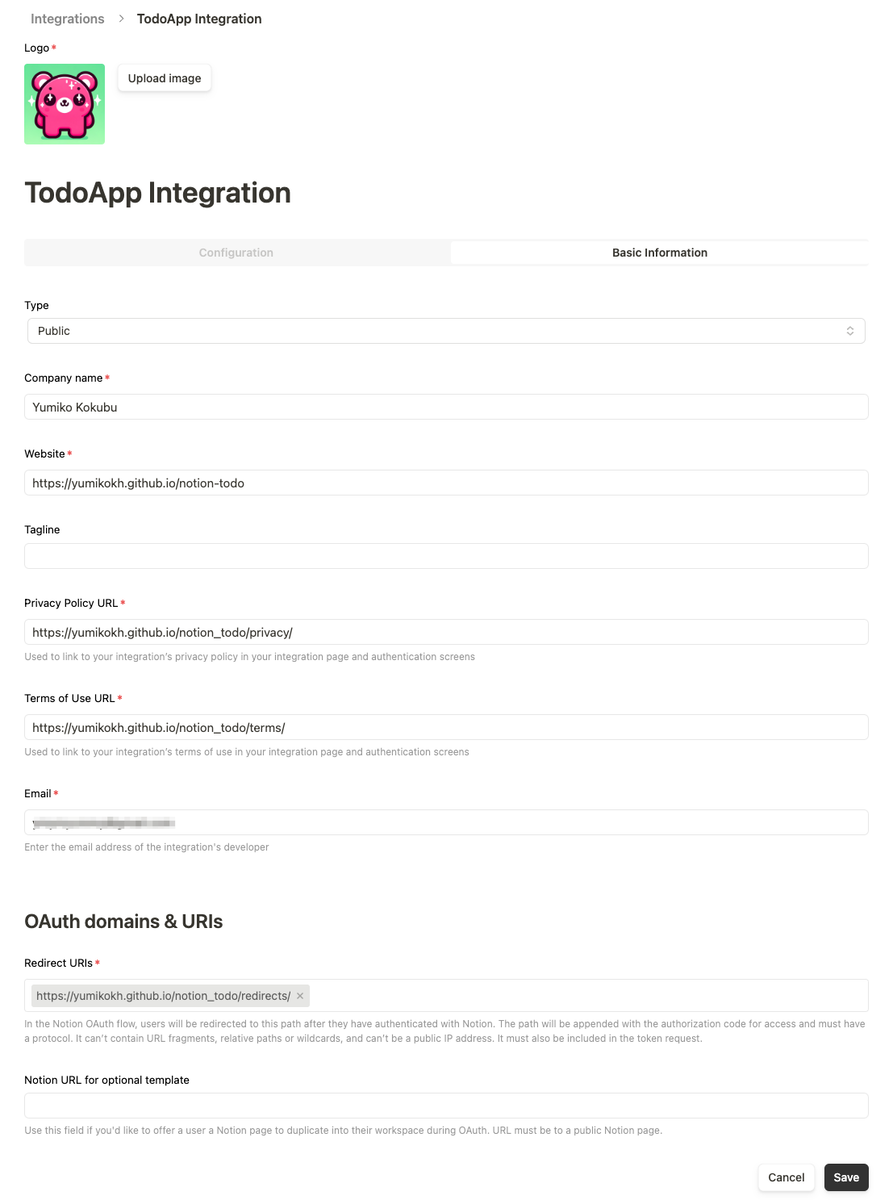ユーザーにNotionへのアクセスを許可してもらいたいときに利用する、OAuth認証の実装方法です。
全体の流れ
ざっくりこのような流れになります。🟨はユーザー操作です。

1. リダイレクト先のページを作成
2のPublic Integrationを作成するときに必要なページを最低3種類用意します。
- Privacy Policy
- Integrationページと認証画面でプライバシーポリシーにリンクするために使用されます
- Terms of Use
- Integrationページと認証画面で利用規約にリンクするために使用されます
- Redirect URI
- 認証後に受け取る
codeをパラメータとして受取り、アプリへリダイレクトさせるために使用されます
- 認証後に受け取る
- Fallback (Optional)
- 認証時に失敗したときに表示するページです
上の2つはいったん中身は仮でURLだけあればOKですが、RedirectURIはNotion認証から受け取った code をパラメータに含んだ状態でアプリへリダイレクトさせる実装が必要です。(ちなみに私はGithubページで作成しました。)
実装例
<!DOCTYPE html> <html lang="en"> <head> <meta charset="UTF-8" /> <meta name="viewport" content="width=device-width, initial-scale=1.0" /> <meta name="robots" content="noindex" /> <title>Notion-Todo Redirects</title> </head> <body> <script> var urlParams = new URLSearchParams(window.location.search); var code = urlParams.get("code"); if (code == null) { window.location.replace({FallbackページURL}); } else { window.location.replace("notiontodo://oauth/callback?code=" + code); } </script> </body> </html>
notiontodo は、3で設定するUrlSchemeなので、適宜変更してください。
2. Public Integrationの作成
こちらから新しいIntegrationを作成します。
「Type」は Public を選択し、1で作成したURLを使って必須項目を埋めていきます。

作成に成功すると、 設定画面から利用可能な OAuth Client ID, OAuth Client Secret, Authorization URL が取得できます。
3. アプリ側の実装
flutterでの実装例です。
- NotionIntegrationで取得する
Authorization URLへ遷移します。UrlSchemeもここで指定します。- 今回は flutter_web_auth_2 packageを利用
https://api.notion.com/v1/oauth/tokenへPOSTリクエストを行いtokenを取得します
import 'dart:async'; import 'dart:convert'; import 'package:http/http.dart' as http; import 'package:flutter_web_auth_2/flutter_web_auth_2.dart'; class NotionOAuthRepository { final String notionAuthUrl; final String clientId; final String clientSecret; final String redirectUri; NotionOAuthRepository( this.notionAuthUrl, this.clientId, this.clientSecret, this.redirectUri); Future<String?> fetchAccessToken() async { try { final result = await FlutterWebAuth2.authenticate( url: notionAuthUrl, callbackUrlScheme: "notiontodo"); final code = Uri.parse(result).queryParameters['code']; if (code != null) { final encoded = base64.encode(utf8.encode('$clientId:$clientSecret')); final res = await http.post( Uri.parse('https://api.notion.com/v1/oauth/token'), headers: { 'Content-Type': 'application/json', 'Authorization': 'Basic $encoded', }, body: jsonEncode({ 'grant_type': 'authorization_code', 'code': code, 'redirect_uri': redirectUri, }), ); final data = jsonDecode(res.body); return data['access_token']; } else { throw Exception('oAuth Code is null'); } } catch (e) { print('Failed to fetch access token: $e'); return null; } } }
取得したtokenをAuthorization: Bearer {token} としてヘッダーに付与することでNotionAPIを利用することができます。